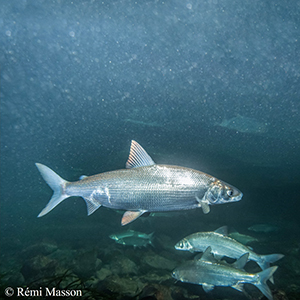Synchrony in whitefish stock dynamics: disentangling the effects of local drivers and climate

All claims expressed in this article are solely those of the authors and do not necessarily represent those of their affiliated organizations, or those of the publisher, the editors and the reviewers. Any product that may be evaluated in this article or claim that may be made by its manufacturer is not guaranteed or endorsed by the publisher.
Authors
Synchronic variations in abundance in populations of the same species are common phenomena encountered in various environments, including lakes, and different taxa of freshwater fishes. This phenomenon can be caused by similar environmental conditions across physically separated populations. In the context of the ongoing climate change, it is essential to test this hypothesis, identify the factors driving the synchrony and elucidate the mechanisms, in the attempt to improve fisheries management. This study investigates synchronic variations in European whitefish (Coregonus spp.) populations in five peri-alpine lakes. The hypothesis suggests that shared biotic or abiotic factors contribute to similar trends in whitefish landings. Environmental and seasonal variables impacting the early life stages of the species were analyzed, and the Euclidean distances between the multivariate time series were calculated to identify similarities or dissimilarities in lake environmental parameters. We found that regional winter and spring temperatures were consistent across the lakes, but these factors did not fully account for variations in landings statistics. Wind intensity, water level and zooplankton abundance showed lake-specific patterns that could better explain local conditions and dynamics. Linear models did not reveal a coherent correlation with a common environmental variable across all lakes. However, distinct relationships were found in four of the lakes, with local factors significantly contributing to abundance variations. The spring abundance of Daphnia spp., a primary food source for whitefish larvae, was the main factor correlated with fish landing trends in Lake Geneva and Lake Bourget. Higher availability of Daphnia spp. may decrease intraspecific competition and density-dependent mortality. In Lake Neuchâtel, winter water temperature was negatively correlated with fish abundance proxies, suggesting that warmer winters may compromise reproduction success. Lake Annecy saw an increase in whitefish landings following a substantial reduction in fishing efforts during the late 2000s. A significant negative correlation was found between whitefish landings and fishing efforts. No relationship was found for Lake Aiguebelette, maybe due to a lack of zooplankton data. In conclusion, the observed synchrony in the European whitefish population is likely driven by a combination of interacting environmental and anthropogenic factors rather than a single common variable. Further research and a more detailed dataset are needed to better understand these complex relationships.
Article cover image: Whitefish (Credit: Rémi Masson)
Edited by
Diego Fontaneto, National Research Council, Water Research Institute (CNR-IRSA), Verbania Pallanza, ItalyHow to Cite

This work is licensed under a Creative Commons Attribution-NonCommercial 4.0 International License.






